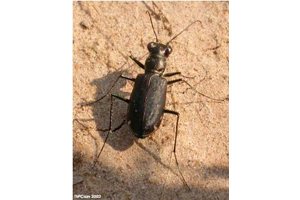When handled, adults emit a fruity odor that resembles the smell of apples.
Photo Credit: Patrick Coin
Cicindela punctulata
Common Name: punctured tiger beetle
Other Common Names: backroad tiger beetle, sidewalk tiger beetle
Animal Guild: Insect
Class > Order > Family: Insecta > Coleoptera > Carabidae
